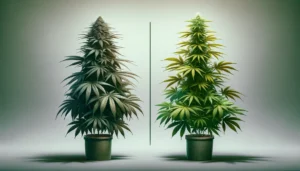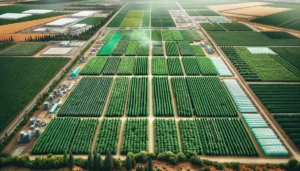Navigating the Spectrum: Indica, Sativa, and the Blurred Lines in Cannabis Strains
 The vast world of cannabis is characterized by its diversity, with thousands of unique strains that cater to an array of consumer needs. At the crux of this botanical bounty are two well-known categories—indica and sativa—whose names have become synonymous with distinct highs. But do these labels truly encapsulate the nuanced effects and benefits? This post explores the traditional dichotomy between indica and sativa strains, examines their physical traits, and dives into the reality of modern hybrid varietals, which often challenge these long-standing stereotypes.
The vast world of cannabis is characterized by its diversity, with thousands of unique strains that cater to an array of consumer needs. At the crux of this botanical bounty are two well-known categories—indica and sativa—whose names have become synonymous with distinct highs. But do these labels truly encapsulate the nuanced effects and benefits? This post explores the traditional dichotomy between indica and sativa strains, examines their physical traits, and dives into the reality of modern hybrid varietals, which often challenge these long-standing stereotypes.
Unveiling the Traditionally Defined ‘Indica’
Beyond Physicality
Indica plants have long been recognized for their short, robust stature and broad foliage. Typically growing faster and yielding more substantial crops than their sativa counterparts, the indica species were historically cultivated for their adaptability and resilience. Their compact size made them convenient for indoor growth, and their rapid development suited the stringent seasonal constraints of outdoor farming.
The ‘In Da Couch’ Experience
The indica effect, often characterized as a “body high,” is celebrated for its capacity to soothe and relax. Consumers frequently turn to indica-dominant strains to address ailments like insomnia, chronic pain, and stress that is held in the tension of muscles. Indica’s sedative properties make it a popular choice for winding down, and its presence in numerous medical cannabis formulations cannot be overstated.
Decoding the Traditional ‘Sativa’
Growth and Appearance
Conversely, sativa plants are best known for their towering presence and slender profile, a visual distinction that evolved to maximize sun exposure in equatorial climates. Slow to mature and light-hungry, these giants are often associated with warm, tropical regions and a distinctly different growing environment from that of the indica varieties.
The Mind’s Playground
The stereotypical “head high” attributed to sativa strains becomes manifest in the form of increased creativity, heightened alertness, and an uplifting energetic surge. Consumed during the daytime, these strains can help manage mood disorders, stimulate productivity, and fend off malaise—a testament to their original purpose of enduring the rigors of the sun-drenched cultivation.
The Rise of the Hybrid
 An exciting trend in cannabis cultivation is the intentional crossbreeding of indica and sativa plants.
An exciting trend in cannabis cultivation is the intentional crossbreeding of indica and sativa plants.
These hybrids are not only a marriage of growth characteristics but also an amalgamation of effects.
While some hybrids may lean heavily towards either indica or sativa in their influence, others are painstakingly balanced to offer a “best of both worlds” scenario.
This tailoring of effects has propelled hybrids into the limelight, with many consumers favoring the predictability and flexibility they offer.
A New Generation of Cannabis
Hybridization marks a pivotal departure from the strict categorization of cannabis strains and challenges the idea that every plant must be classified as either indica or sativa. Modern cultivation techniques, including controlled breeding and advanced genetic testing, have given rise to a rich tapestry of options, each with its unique blend of cannabinoids, terpenes, and flavonoids. This innovation allows for strains that cater to specific conditions, preferences, and times of day, ensuring that no physiological state goes unaided.
Individual Variables and Environmental Influences
It’s crucial to understand that the experiences with cannabis are highly subjective and individualized. Genetics play a role not only in the plant’s makeup but also in how its compounds interact with the consumer’s endocannabinoid system. Furthermore, environmental factors such as soil composition, climate, and cultivation methods can impact the final product.
Robust Research for Personalized Results
With the increasing availability of well-researched strains, consumers can pursue their preferred outcomes with greater precision. The current trend toward informed consumption is underpinned by scientific inquiry, with a burgeoning body of knowledge urging users to look beyond indica and sativa labels and toward the cannabinoid and terpene profiles that are truly indicative of a strain’s effects.
Parting Thoughts
The dichotomy between indica and sativa has served as an entry point into the world of cannabis for many enthusiasts. However, as we teeter on the brink of a new era of informed choice and personalized wellness, a reevaluation of the terms’ relevance is in order.
A Step toward Informed Consumption
 In the end, it’s not about indica or sativa—it’s about you. Your unique physiology and preferences dictate the strains that elevate your life experience. Through education and experimentation, we inch closer to a future where cannabis consumers can curate their highs with the same acumen as they do their playlists. By dismantling the old dichotomies and championing the complexity of cannabis, we celebrate the richness of this plant and the myriad ways it can enrich our lives.
In the end, it’s not about indica or sativa—it’s about you. Your unique physiology and preferences dictate the strains that elevate your life experience. Through education and experimentation, we inch closer to a future where cannabis consumers can curate their highs with the same acumen as they do their playlists. By dismantling the old dichotomies and championing the complexity of cannabis, we celebrate the richness of this plant and the myriad ways it can enrich our lives.
Cannabis cultivation and consumption are art forms, and the palette is more varied than many have been led to believe. Indica and sativa may have brought us here, but it is the hybrids and unique profiles that will carry us forward. It’s an exciting time to be a part of the cannabis conversation, as we chart a path through the blurred lines to a world where every strain has its place and every high its purpose.
For those curious about the intricate world of cannabinoids, pondering the question, “What Is The Difference Between THC And CBD?” can provide a deeper understanding of the plant’s diverse effects.






